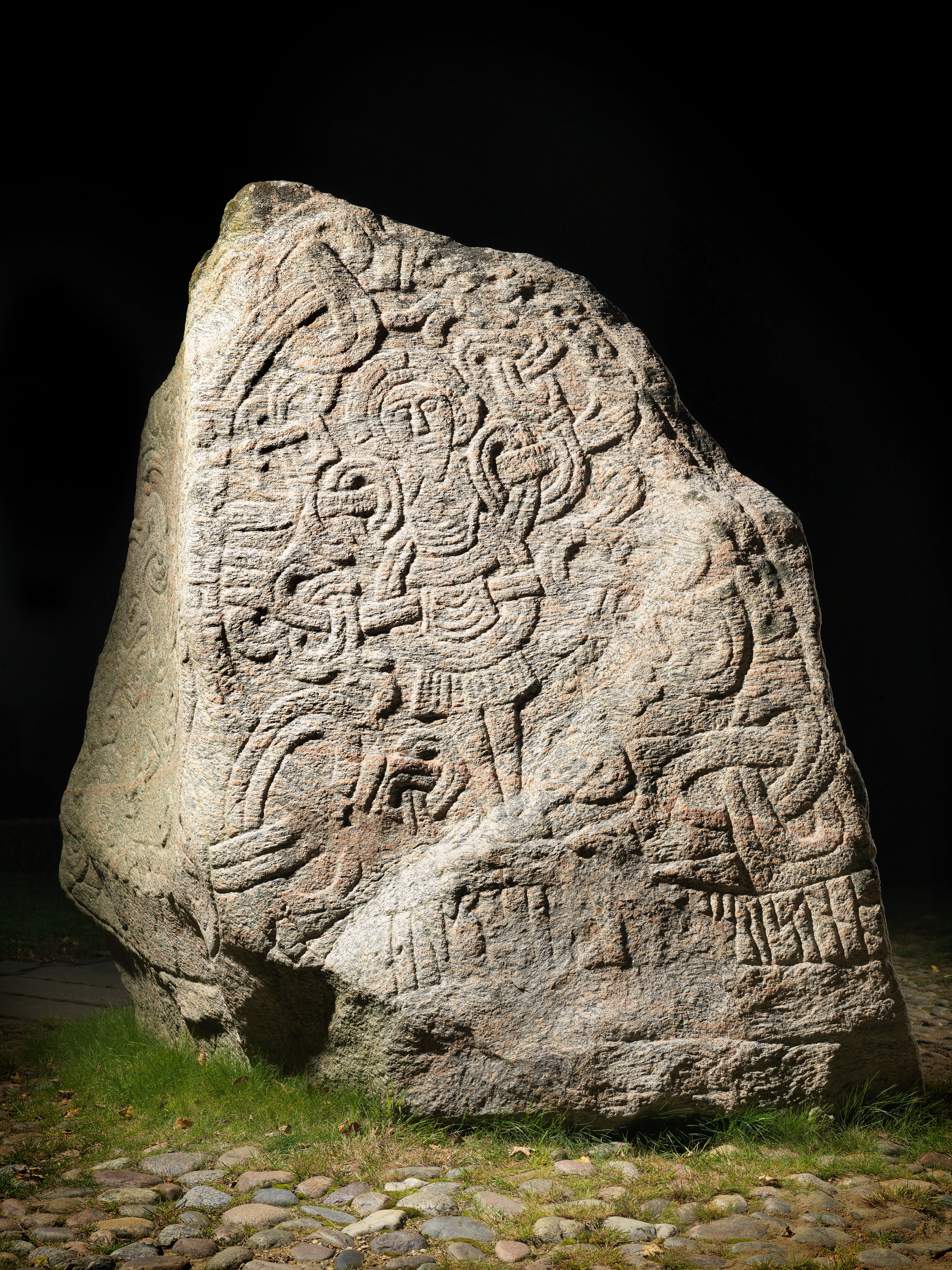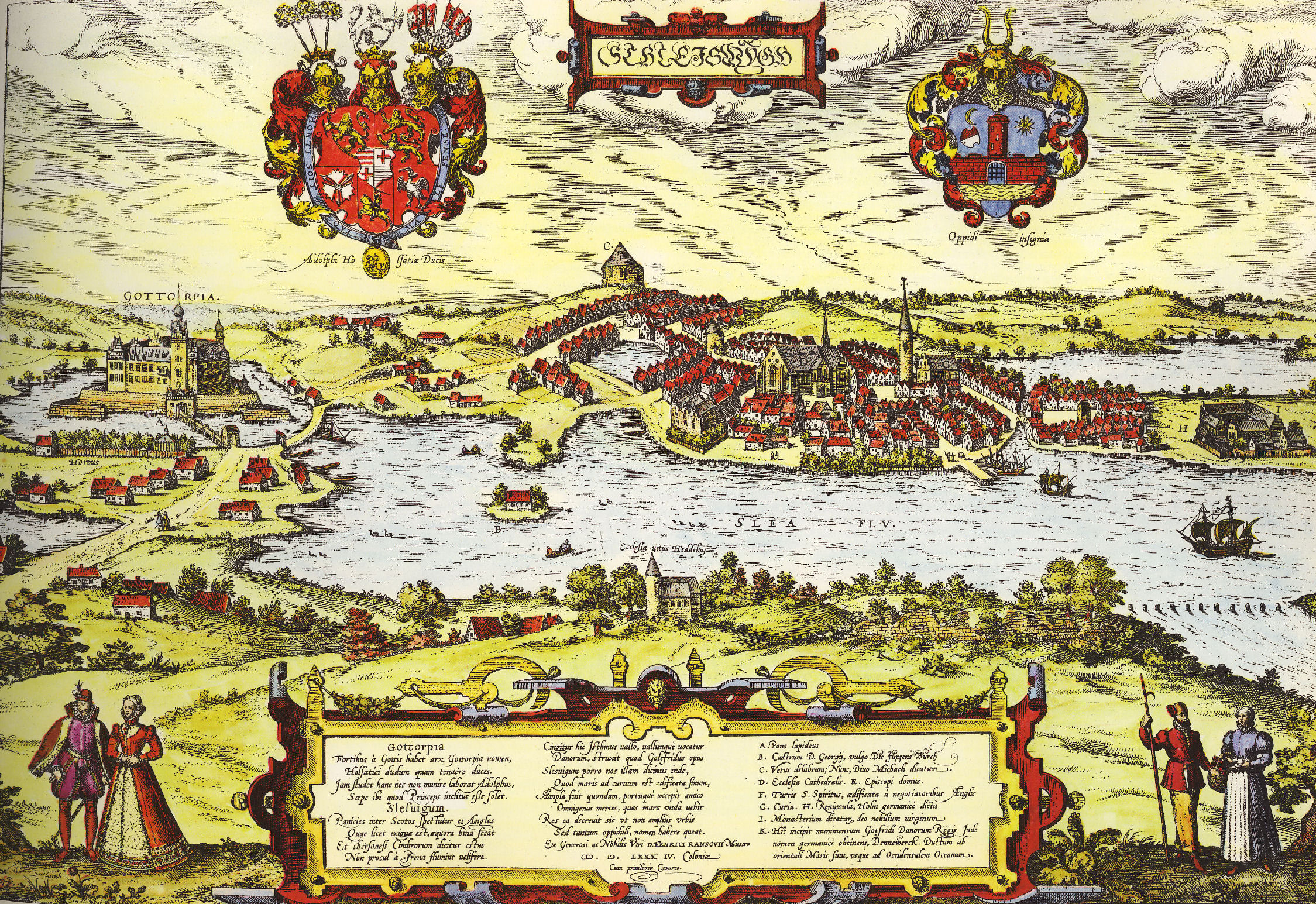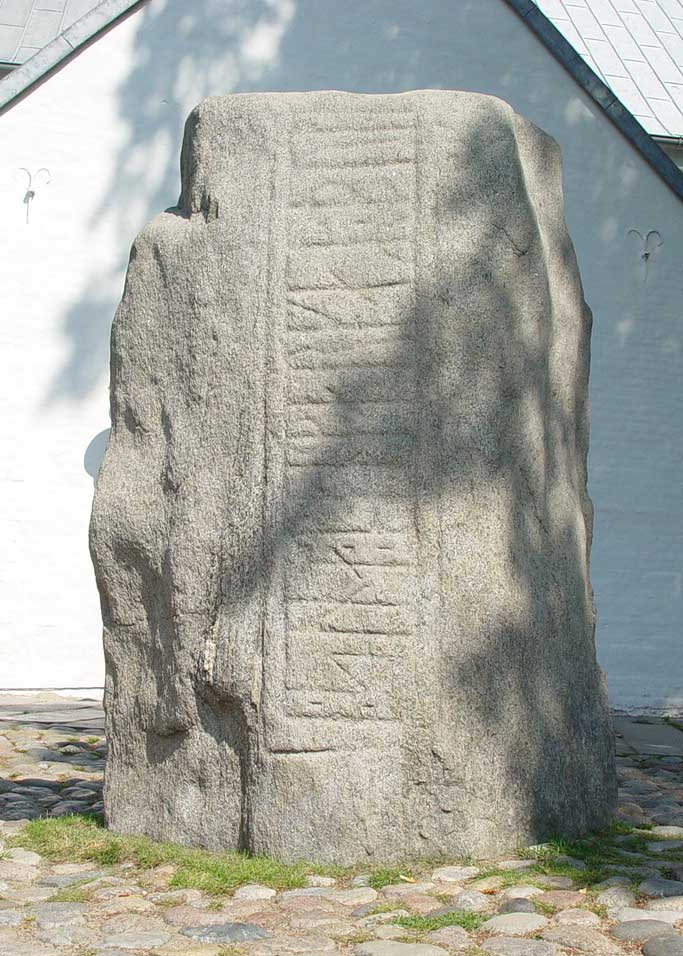|
Sigtrygg Of Denmark
Sigtrygg Gnupasson was semi-legendary a king of Denmark of the House of Olaf who ruled in the 10th century, according to Adam of Bremen. Sigtrygg was son of Gnupa and the Danish noblewoman Asfrid. According to Adam, he became a Danish king during the tenure of Archbishop Hoger of Bremen (909–915/7). He is remembered on the two Sigtrygg Runestones found near Schleswig, (DR2 and DR4), erected by his mother after his death, suggesting this area represented the power-base of the family.''Asfriþr karþi kumbl þaun aft Siktriku sun sin aui Knubu'' (Asfrith carved this gravestone after Sigtrygg, her son and Gnupa's); ''Ui Asfriþr karþi kubl þausi tutir Uþinkars aft Sitriuk kununt sun sin auk Knubu'' (Holy Asfrith carved this gravestone, Odinkar's daughter, after Sigtrygg, king, her son and Gnupa's). A. V. Storm, "Pages of Early Danish History, from the Runic Monuments of Sleswick and Jutland", ''The Saga=Book of the Viking club'', vol. 2, pp. 328–347. Based on the testimony ... [...More Info...] [...Related Items...] OR: [Wikipedia] [Google] [Baidu] |
King Of Denmark
The monarchy of Denmark is a constitutional political system, institution and a historic office of the Kingdom of Denmark. The Kingdom includes Denmark proper and the autonomous administrative division, autonomous territories of the Faroe Islands and Greenland. The Kingdom of Denmark was already consolidated in the 8th century, whose rulers are consistently referred to in Franks, Frankish sources (and in some late Frisians, Frisian sources) as "kings" (). Under the rule of King Gudfred in 804 the Kingdom may have included all the major provinces of medieval Denmark. The current unified Kingdom of Denmark was founded or re-united by the Vikings, Viking kings Gorm the Old and Harald Bluetooth in the 10th century. Originally an elective monarchy, it became hereditary monarchy, hereditary only in the 17th century during the reign of Frederick III of Denmark, Frederick III. A decisive transition to a constitutional monarchy occurred in 1849 with the writing of the first democrat ... [...More Info...] [...Related Items...] OR: [Wikipedia] [Google] [Baidu] |
Schleswig, Schleswig-Holstein
Schleswig (, , ; da, Slesvig; South Jutlandic: ''Sljasvig''; nds, Sleswig; archaic English: ''Sleswick'') is a town in the northeastern part of Schleswig-Holstein, Germany. It is the capital of the '' Kreis'' (district) Schleswig-Flensburg. It has a population of about 27,000, the main industries being leather and food processing. It takes its name from the Schlei, an inlet of the Baltic sea at the end of which it sits, and ''vik'' or ''vig'' which means "bay" in Old Norse and Danish. Schleswig or Slesvig therefore means "bay of the Schlei". History The Viking settlement of Hedeby, located south of the modern town, was first mentioned in 804. It was a powerful settlement in the Baltic region, dominating the area for more than 200 years. In 1050, following several destructions, the population was moved to the opposite shore of the Schlei, becoming the city of Schleswig. In 1066 Hedeby was finally destroyed, and Schleswig remained as a part of the Danish kingdom. In 1544, Gottor ... [...More Info...] [...Related Items...] OR: [Wikipedia] [Google] [Baidu] |
10th-century Deaths
1 (one, unit, unity) is a number representing a single or the only entity. 1 is also a numerical digit and represents a single unit of counting or measurement. For example, a line segment of ''unit length'' is a line segment of length 1. In conventions of sign where zero is considered neither positive nor negative, 1 is the first and smallest positive integer. It is also sometimes considered the first of the infinite sequence of natural numbers, followed by 2, although by other definitions 1 is the second natural number, following 0. The fundamental mathematical property of 1 is to be a multiplicative identity, meaning that any number multiplied by 1 equals the same number. Most if not all properties of 1 can be deduced from this. In advanced mathematics, a multiplicative identity is often denoted 1, even if it is not a number. 1 is by convention not considered a prime number; this was not universally accepted until the mid-20th century. Additionally, 1 is the s ... [...More Info...] [...Related Items...] OR: [Wikipedia] [Google] [Baidu] |
List Of Danish Monarchs
This is a list of Danish monarchs, that is, the kings and queens regnant of Denmark. This includes: * The Kingdom of Denmark (up to 1397) ** Personal union of Denmark and Norway (1380–1397) * The Kalmar Union (1397–1536) ** Union of Denmark, Norway and Sweden (1397–1523) ** Union of Denmark and Norway (1523–1536/1537) * The United Kingdoms of Denmark–Norway (1536/1537–1814) * The Kingdom of Denmark (1814–present) ** Iceland (since the union between Denmark and Norway in 1380; independent kingdom in a personal union with Denmark 1918–1944; a sovereign republic since 1944) ** Greenland (since the union between Denmark and Norway in 1380; effective Danish–Norwegian control began in 1721; integrated into the Danish realm in 1953; internal home rule introduced 1979; self-determination assumed in 2009; Greenland has two out of 179 seats in the Danish parliament Folketinget) ** Faroe Islands (since the union between Denmark and Norway in 1380; County of Denmark 1816– ... [...More Info...] [...Related Items...] OR: [Wikipedia] [Google] [Baidu] |
Gesta Wulinensis Ecclesiae Pontificum
Gesta may refer to: Titles of works Gesta is the Latin word for "deeds" or "acts", and Latin titles, especially of medieval chronicles, frequently begin with the word, which thus is also a generic term for medieval biographies: *Gesta Adalberonis or Gesta Alberonis, "Deeds of Albero", Archbishop of Trier (1131–52) * Gesta Berengarii imperatoris, "Deeds of the Emperor Berengar", epic poem chronicling the career of Berengar of Friuli from c.874 to 915 *Gesta comitum Barcinonensium et regum Aragoniae, "Deeds of the counts of Barcelona and kings of Aragon", 14th century *Gesta Cnutonis Regis or Encomium Emmae Reginae, "Deeds of King Canute" 11th-century, also covers Queen Emma of Normandy *Gesta Danorum, "Deeds of the Danes", 12th century *Dei gesta per Francos, "Deeds of God through the Franks", 12th century, a narrative of the First Crusade *Gesta Francorum, "The Deeds of the Franks", in full Gesta Francorum et aliorum Hierosolimitanorum ("The deeds of the Franks and the other pilgr ... [...More Info...] [...Related Items...] OR: [Wikipedia] [Google] [Baidu] |
Gorm The Old
Gorm the Old ( da, Gorm den Gamle; non, Gormr gamli; la, Gormus Senex), also called Gorm the Languid ( da, Gorm Løge, Gorm den Dvaske), was ruler of Denmark, reigning from to his death or a few years later.Lund, N. (2020), p. 147''Pilemedia'' (in Swedish), 25 October 2020 |
Heimskringla
''Heimskringla'' () is the best known of the Old Norse kings' sagas. It was written in Old Norse in Iceland by the poet and historian Snorre Sturlason (1178/79–1241) 1230. The name ''Heimskringla'' was first used in the 17th century, derived from the first two words of one of the manuscripts (''kringla heimsins'', "the circle of the world"). ''Heimskringla'' is a collection of sagas about Swedish and Norwegian kings, beginning with the saga of the legendary Swedish dynasty of the Ynglings, followed by accounts of historical Norwegian rulers from Harald Fairhair of the 9th century up to the death of the pretender Eystein Meyla in 1177. The exact sources of the Snorri's work are disputed, but they include earlier kings' sagas, such as Morkinskinna, Fagrskinna and the 12th-century Norwegian synoptic histories and oral traditions, notably many skaldic poems. He explicitly names the now lost work ''Hryggjarstykki'' as his source for the events of the mid-12th century. Although Sno ... [...More Info...] [...Related Items...] OR: [Wikipedia] [Google] [Baidu] |
Harthacnut I Of Denmark
Harthacnut or Cnut I ( da, Hardeknud) was a semi-legendary King of Denmark. The old Norse story ''Ragnarssona þáttr'' makes Harthacnut son of the semi-mythic viking chieftain Sigurd Snake-in-the-Eye, himself one of the sons of the legendary Ragnar Lodbrok. The saga in turn makes Harthacnut the father of the historical king, Gorm. It has been suggested he is to be identified with the Hardegon of ''Northmannia'' whose early-10th century conquest of Denmark was related by Adam of Bremen. ''Ragnarssona þáttr'' The saga ''Ragnarssona þáttr'' relates the acts of the sons of Ragnar Lodbrok, and proceeds to link them genealogically to the later rulers of the Scandinavian kingdoms. For Denmark, it relates that by Blaeja, the daughter of King Ælla of Northumbria, Sigurd Snake-in-the-Eye became father of Harthacnut (''Hörða-Knútr''). Harthacnut is said to have been his father's successor in Zealand, Scania and Halland, but not the break-away Viken, and he was father of Gorm. ... [...More Info...] [...Related Items...] OR: [Wikipedia] [Google] [Baidu] |
Rundata
The Scandinavian Runic-text Data Base ( sv, Samnordisk runtextdatabas) is a project involving the creation and maintenance of a database of runic inscriptions. The project's goal is to comprehensively catalog runestones in a machine-readable way for future research. The database is freely available via the Internet with a client program, called Rundata, for Microsoft Windows. For other operating systems, text files are provided or a web browser can be used to interact with the web applicatioRunor History The origin of the Rundata project was a 1986 database of Swedish inscriptions at Uppsala University for use in the Scandinavian Languages Department. At a seminar in 1990 it was proposed to expand the database to cover all Nordic runic inscriptions, but funding for the project was not available until a grant was received in 1992 from the ''Axel och Margaret Ax:son Johnsons'' foundation. The project officially started on January 1, 1993 at Uppsala University. After 1997, the proje ... [...More Info...] [...Related Items...] OR: [Wikipedia] [Google] [Baidu] |
Sigtrygg Runestones
The two Sigtrygg Runestones, designated as DR 2 and DR 4 in the Rundata catalog, are two of the Hedeby stones that were found in Schleswig-Holstein, Germany, which during the Viking Age was part of Denmark. The runestones were raised after the Danish king Sigtrygg Gnupasson by his mother Ásfriðr. Together with the account of Adam of Bremen, the two inscriptions constitute evidence for the House of Olaf on the Danish throne. The stones are dated as being carved after 934 C.E. as the historian Widukind of Corvey recorded that King Gyrd and Gnupa, Gnupa, who is mentioned in both inscriptions, was forced to pay a tribute to the German king in that year. DR 2 DR 2 was found at Haddeby in Schleswig-Holstein in 1797. At one time, scholars considered the word and rune selection on this runestone, when compared with the inscription on DR 4, along with other inscriptions as evidence of Swedish influence in Denmark during the 10th century. For example, although both DR 2 and DR 4 use the Y ... [...More Info...] [...Related Items...] OR: [Wikipedia] [Google] [Baidu] |
Gyrd And Gnupa
Gyrd and Gnupa were kings of Denmark in the 10th century according to Sweyn II of Denmark and Adam of Bremen. They were the sons of the Swedish chieftain Olof (or Olaf) the Brash who had conquered Denmark and they ruled together according to Swedish tradition. Gnupa is mentioned on the two Sigtrygg Runestones raised near Schleswig by his wife Asfrid for their son Sigtrygg. Likewise a Danish king ''Chnuba'' is named by Widukind of Corvey's Saxon chronicles as having been defeated and forced to accept baptism in 934, and Olav Tryggvasson's Saga tells of Gnupa's defeat by Gorm the Old. However, this chronology would contradict that of Adam of Bremen, who places the succession and subsequent defeat of Sigtrygg during the tenure of Archbishop Hoger of Bremen (909–915/7). The late and legend-influenced Gesta Danorum of Saxo Grammaticus names a nobleman ''Ennignup'' serving as guardian for a young king Knut at some time prior to king Gorm the Old Gorm the Old ( da, Gorm den Gam ... [...More Info...] [...Related Items...] OR: [Wikipedia] [Google] [Baidu] |
Adam Of Bremen
Adam of Bremen ( la, Adamus Bremensis; german: Adam von Bremen) (before 1050 – 12 October 1081/1085) was a German medieval chronicler. He lived and worked in the second half of the eleventh century. Adam is most famous for his chronicle ''Gesta Hammaburgensis ecclesiae pontificum'' (''Deeds of Bishops of the Hamburg Church''). He was "one of the foremost historians and early ethnographers of the medieval period". In his chronicle, he included a chapter mentioning the Norse outpost of Vinland, and was thus the first European to write about the New World. Life Little is known of his life other than hints from his own chronicles. He is believed to have come from Meissen, then its own margravate. The dates of his birth and death are uncertain, but he was probably born before 1050 and died on 12 October of an unknown year (possibly 1081, at the latest 1085). From his chronicles, it is apparent that he was familiar with a number of authors. The honorary name of ''Magister Adam'' sho ... [...More Info...] [...Related Items...] OR: [Wikipedia] [Google] [Baidu] |






